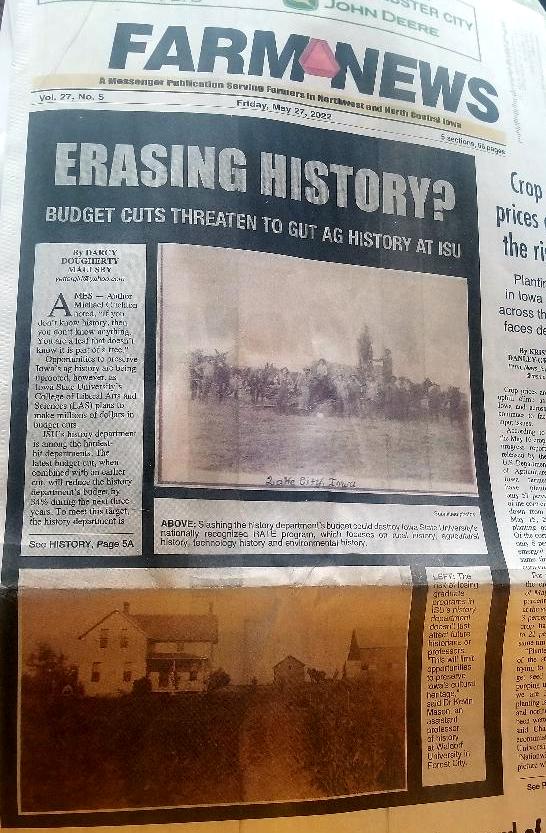
Whats HOT
Latest Posts

Machines that Changed America: John Froelich Invents the First Tractor in Iowa
Today, it’s hard to imagine a cornfield without a tractor in the picture. I was thinking about tractor history when The History Channel featured “The Machines That Built America.” I was glad to see they included the story of John Froelich, which I featured in my 2020 book Iowa Agriculture: A History of Farming, Family and Food.
Here’s an excerpt:
Back in 1892 in the tiny village of Froelich in Clayton County, Iowa, however, folks were amused by what a local businessman, John Froelich, was saying.
This northeast Iowa entrepreneur (1849 -1933) believed that mechanical power had a great future—that someday traction engines would do the work of horses even on mid-sized and large farms. The locals had to admit, though, that Froelich had invented several handy gadgets, including a more efficient washing machine, plus he was a good businessman.
Froelich ran a grain elevator, plus he ran a well-digging business and operated a threshing rig. Every year he took a crew of men to Langford, South Dakota, to work the fields. Froelich had considerable experience with steam engines and knew their pitfalls. They were heavy and bulky. They were hard to maneuver. They were always threatening to set fire to the grain and stubble fields. On the flat prairie, with a strong wind blowing, that was no joke.
A frustrated Froelich decided he could invent a better way to power the engine. The solution was gasoline. Froelich and local blacksmith Will Mann came up a vertical, one-cylinder engine mounted on the running gear of a steam traction engine – a hybrid of their own making. They designed many new parts to make it all fit together, but it finally was done. The word “tractor” wasn’t used in those days, but that’s what Froelich invented.
A few weeks later Froelich and his crew started for the broad fields of South Dakota with the “tractor” and a new threshing machine. That fall they threshed 72,000 bushels of small grain. It was a success!
Later that fall, Froelich shipped his “tractor” to Waterloo, Iowa, to show some businessmen. Immediately, the men formed a company to manufacture the “Froelich Tractor.” They named the company The Waterloo Gasoline Traction Engine Company and made Froelich the president.
Unfortunately, efforts to sell the practical, gasoline-powered tractor failed. Two were sold and shortly returned. The company then decided to manufacture stationary gas engines to provide income while tractor experiments continued, according to the Froelich Museum.
In 1895, the Waterloo Gasoline Engine Company was incorporated, but Froelich, whose interest was in tractors, not stationary engines, chose to withdraw from the company. The Waterloo Company continued to build stationary engines while trying to improve the tractor. In 1913 the model “L-A” was made.
In 1914, the first Waterloo Boy tractor, the Model “R” single-speed tractor, was introduced. Farmers liked it, and sales reached 118 within a year. When the Model “N” Waterloo Boy with two forward speeds was introduced, it was also successful.
When World War I led to rising farm prices and strong demand for dependable mechanical farm power, the concept of the tractor became so popular many tractor manufacturers sprung up in a matter of months. Deere and Company in Moline, Illinois, which manufactured a full line of John Deere implements, had been watching the progress of the Waterloo Engine Company and the increasing quality of its products.
Deere was looking for an established farm tractor to round out its line, and the Waterloo Engine Company fit the bill. Today, Deere’s facility in Waterloo remains one of the largest tractor-producing plants in the nation.
Tractors of various types and sizes that make farming easier and more efficient are shipped to farmers all over the world. For this contribution, John Froelich will long be remembered, and the village of Froelich, Iowa, remains “Tractor Town U.S.A.”
Tractor enthusiasts from around the globe travel to this tiny village to visit the birthplace of the tractor. At the 1891 general store, guests can view a scale model of the first “Froelich Tractor” made from the original blueprints. Perhaps the monument erected in 1939 near the general store best captures the essence of this unique place.
“In this village, John Froelich built the first gasoline tractor that propelled itself backwards as well as forward. Far-reaching in its effect on modern agricultural history, it moved out of this village and into the world in 1892. Later that year, Mr. Froelich joined with others in organizing the Waterloo Gasoline Traction Engine Company, which later became the John Deere Tractor Company.”
Meeting the challenge of a reliable, durable tractor
This history took center stage at the 2018 Iowa State Fair in Des Moines, when a butter sculpture of the Waterloo Boy Tractor stood next to the world-famous Butter Cow in the John Deere Agriculture Building’s 40-degree cooler throughout the fair, which ran from August 9-19.
To understand the significance of the Waterloo Boy, take a trip back in time, said Neil Dahlstrom, manager of the John Deere Archives and History. In the critical five-year stretch (1912-1917) prior to John Deere entering the tractor business, there were two key issues to address.
“First, what did farmers really want from a machine that would soon make the horse obsolete?” said Dahlstrom, who noted that salesmen, territory and branch managers, and Deere’s top leadership scoured the country to understand what customers desired. Also, how could the equipment to be manufactured to be durable enough to stand up to daily farm use?
Deere had considered every imaginable idea. The company had developed one-, two- and four-cylinder concept tractors. Some ran on gasoline. Others ran on kerosene. Some had all-wheel drive. Others had front-wheel drive. The company even explored concepts like line steering, which was meant to replicate horse reins as the steering mechanism to ease farmers into power farming, Dahlstrom said.
A motorized cultivator, what Deere called a “Tractivator,” was brought to market by several competitors, but Deere determined it did not provide any cost savings compared to horses.
The challenge of producing a durable tractor loomed large. In a letter to company president William Butterworth in 1915, Deere’s superintendent of factories George Mixter noted that tractors offered by competitors up to that point “have not been built with the proper spirit behind the design and manufacture to insure their durability in the hands of the farmers.” But if Deere could “build a small tractor that will really stand up for five or more years’ work on the farm, I believe they will be a permanent requirement of the American farmer,” Mixter wrote.
Deere ultimately found the solution with the Waterloo Boy tractor and acquired the Waterloo Gasoline Engine Company in Waterloo, Iowa, on March 14, 1918. Although anxious to start selling the Waterloo Boy, Deere dealers had to wait while Deere honored existing contracts, which did not expire until Dec. 31, 1918, Dahlstrom said.
Waterloo Boy makes its debut
Deere put its money where its instincts were. Over the next year, the company spent more than one-third of its advertising budget touting the Waterloo Boy tractor, Dahlstrom said.
Specifically, Deere invested $50,000 on tractor advertising in the year following its debut of the Waterloo Boy—approximately $747,000 in today’s money. Another way to get the company’s new product out in front of customers was to take it on the road – literally.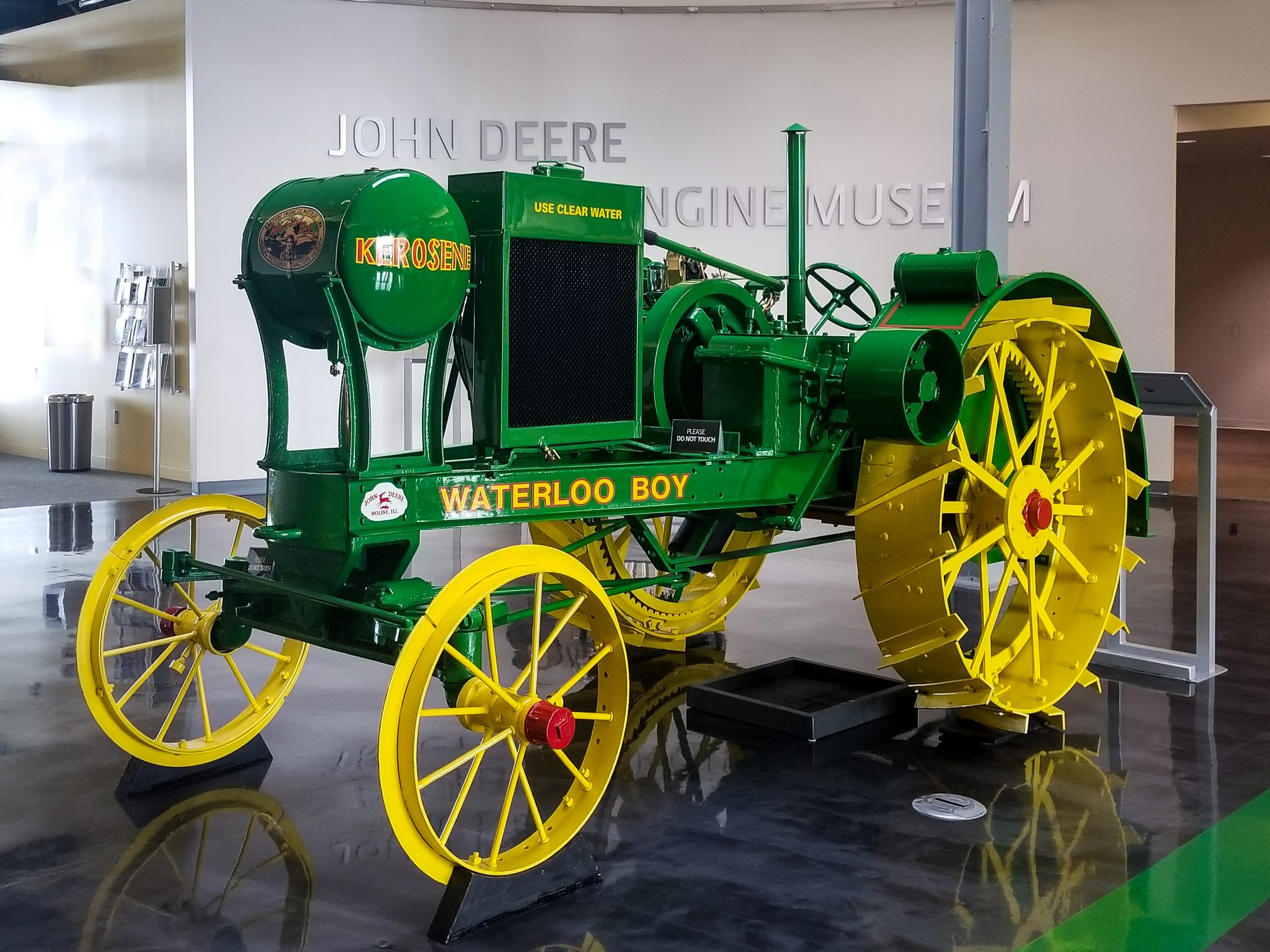 The National Tractor Demonstrations started to become more mainstream after being introduced in the United States in 1913. An eight-city, eight-week tour schedule was the perfect opportunity to unveil Deere’s Waterloo Boy, Dahlstrom said. Salina, Kansas, served as the ideal backdrop in August 1918, since this was the nation’s largest demonstration.
The National Tractor Demonstrations started to become more mainstream after being introduced in the United States in 1913. An eight-city, eight-week tour schedule was the perfect opportunity to unveil Deere’s Waterloo Boy, Dahlstrom said. Salina, Kansas, served as the ideal backdrop in August 1918, since this was the nation’s largest demonstration.
Deere had participated in tractor demonstrations since the original Winnipeg Agricultural Motor Competitions in Manitoba, Canada, in 1908 – but not with a tractor. Instead, Deere had paired its plows with leading tractor manufacturers. That changed now that the Waterloo Boy was part of the Deere family.
At Salina, Deere spared no expense, showcasing 12 Waterloo Boy tractors as the centerpiece of a display that included John Deere signs, Waterloo Boy signs and a copper leaping deer statue, Dahlstrom said. “There were two stars during this week of 100-degree days – ‘ice water on tap’ and the Waterloo Boy Model ‘N’ tractor,” he added.
The Model “N” demonstrated its merits by pulling tractor plows, disc harrows and grain drills. Visitors were shuttled in three John Deere farm wagons pulled by Waterloo Boy tractors. By all accounts, the debut was a success.
“The award for the most elaborate, largest and most artistic exhibit tent at the Salina tractor show will undoubtedly go to the John Deere Plow company of Kansas City,” wrote the editors of a Kansas City newspaper.
As Deere’s advertising campaign swung into full gear, the Waterloo Boy tractor was promoted as the “best and most efficient tractor” on the market for farmers inclined to buy a tractor. By October 1918, readers of Deere’s magazine, The Furrow, saw an advertisement for the line of Waterloo Boy tractors and stationary engines. The ad guaranteed the Waterloo Boy’s “ample power for field and belt work.”
In January 1919, with tractors now available through John Deere dealers, Deere’s first print ad for the trade press appeared in The Farm Implement News. It featured two areas of emphasis: “A Good Tractor Backed by a Permanent Organization.”
After years of development, John Deere customers and John Deere dealers finally had their John Deere tractor. “It took longer than the company expected, but a determination to do it right instead of doing it fast now brought the John Deere tractor to market,” Dahlstrom said.
As a result, customers got “the assurance of more tractor work per dollar of fuel cost; longer tractor life with less repair cost; accessibility of parts that makes caring for the tractor simple and easy; and dependable power for all farm work.”
The tractor era had officially arrived, and Iowa found itself at the epicenter of this growing industry.
Want more?
I invite you to read more of my blog posts if you value intriguing Iowa stories and history, along with Iowa food, agriculture updates, recipes and tips to make you a better communicator.
If you’re hungry for more stories of Iowa history, check out my top-selling “Culinary History of Iowa: Sweet Corn, Pork Tenderloins, Maid-Rites and More” book from The History Press. Also take a look at my other books, including “Iowa Agriculture: A History of Farming, Family and Food” from The History Press, “Madison County,” “Dallas County” and “Calhoun County” book from Arcadia Publishing. All are filled with vintage photos and compelling stories that showcase the history of small-town and rural Iowa. Click here to order your signed copies today! Iowa postcards are available in my online store, too.
If you like what you see and want to be notified when I post new stories, be sure to click on the “subscribe to blog updates/newsletter” button at the top of this page, or click here. Feel free to share this with friends and colleagues who might be interested, too.
Also, if you or someone you know could use my writing services (I’m not only Iowa’s storyteller, but a professionally-trained journalist with 20 years of experience), let’s talk. I work with businesses and organizations within Iowa and across the country to unleash the power of great storytelling to define their brand and connect with their audience through clear, compelling blog posts, articles, news releases, feature stories, newsletter articles, social media, video scripts, and photography. Learn more at www.darcymaulsby.com, or e-mail me at yettergirl@yahoo.com.
Let’s stay in touch. I’m at darcy@darcymaulsby.com, and yettergirl@yahoo.com.
Talk to you soon!

Bob Feller on Farming, Baseball and Military Service
Now that we’re in the time of the year when we take time to honor those who’ve served (Memorial Day), celebrate America (July 4) and maybe even catch a baseball game, I think about the time I interviewed Bob Feller, a Major League Baseball legend and Iowa farm kid.
I’m willing to bet that most people, if they are old enough to remember Feller, know him more for his pitching prowess with the Cleveland Indians. But Feller was also a decorated World War II veteran who gave up some of his prime years of playing professional baseball to serve his country.
“I’m very proud of our military and have a lot of respect for our troops,” said Feller (1918-2010) when I interviewed him in his hometown of Van Meter, Iowa, in 2003.
Known as the “Heater from Van Meter,” Feller signed a pro baseball contract with the Cleveland Indians when he was only 16. “Farm work made me a ball player,” Feller said. “When I was little, I was the water boy for the threshing crew. As I got older, I did it all—I cleaned the barn, milked cows, drove tractors and teams of horses, picked corn and threw bales of hay. Those bales really helped strengthen my arms.”
Feller’s father, Bill, was his first coach. “When I was a kid, Dad built a ball field we called Oak View. That was the first Field of Dreams—not that one from the movies.”
Feller grew up playing baseball at vacation Bible school at the Methodist Church in Van Meter. He also played four years of American Legion baseball in Adel, where his catcher was Nile Kinnick, a future University of Iowa football star who would enlist in the Navy Air Corps Reserve three days after the attacks on Pearl Harbor.
Feller’s father spent hours helping his son develop his baseball skills. “Dad would hit ground balls to me in the hog lot and pitch batting practice to me. We’d practice every night we could. When Mom would call us for supper, we’d always tell her we could eat after dark, but we couldn’t play ball after dark.”
“I never thought twice about enlisting”
By the time Feller played his first game in the major leagues in 1936, the teenaged pitcher struck out 15 St. Louis Browns. Later that season, at age 17, Feller set a new American League record by fanning (striking out) 17 Philadelphia Athletics. In Chicago in 1940, Feller pitched his first of three no-hitters and the only no-hitter pitched on opening day in major league history.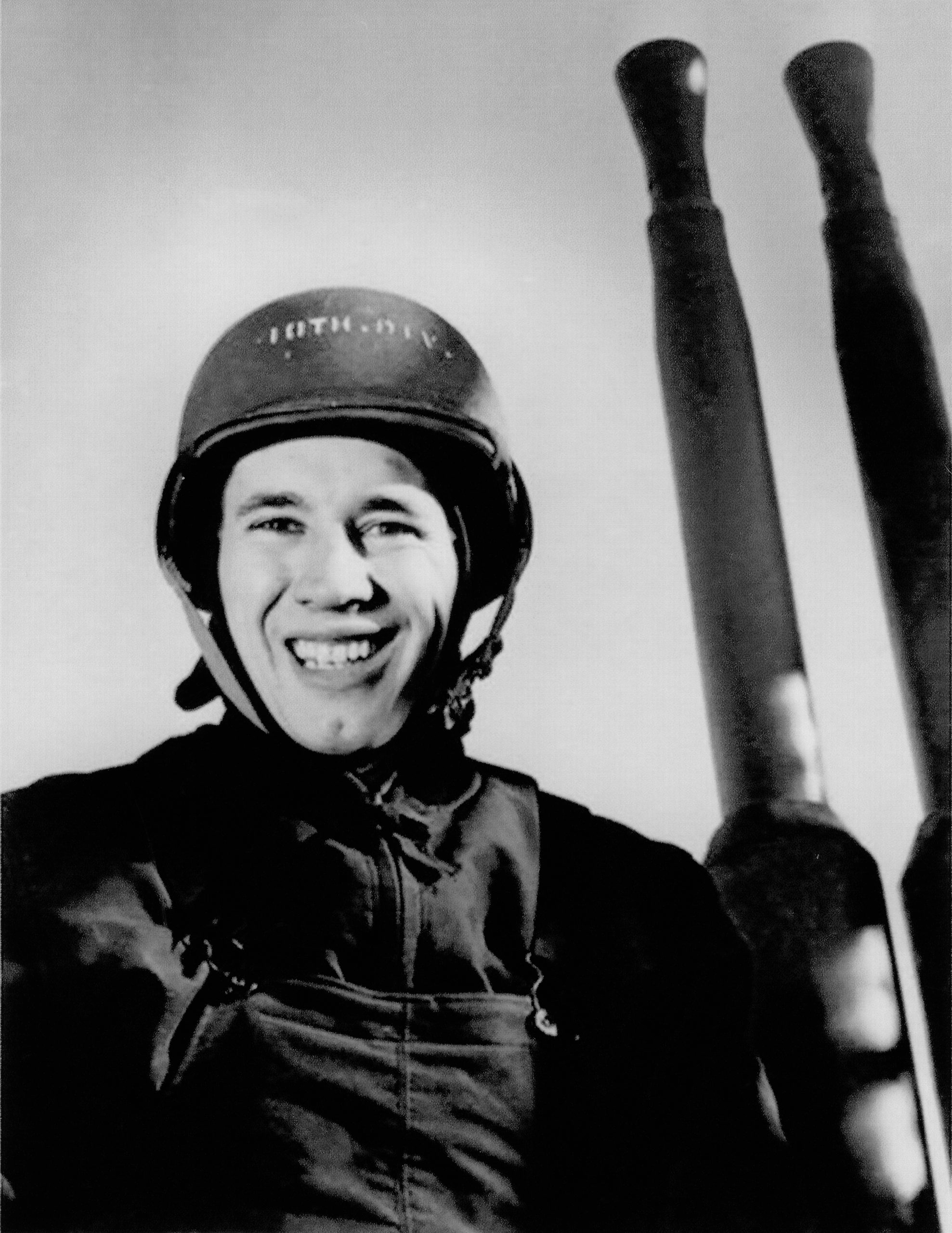 On the eve of World War II, Feller was playing in the big leagues with stars like Ted Williams and Joe DiMaggio. By the time Feller enlisted in the Navy two days after the Pearl Harbor attacks on December 7, 1941, the 22-year-old star had already set a number of major league records.
On the eve of World War II, Feller was playing in the big leagues with stars like Ted Williams and Joe DiMaggio. By the time Feller enlisted in the Navy two days after the Pearl Harbor attacks on December 7, 1941, the 22-year-old star had already set a number of major league records.
While some say Feller’s military service took away what could have been some of his most productive years, Feller doesn’t see it that way.
“I never thought twice about enlisting. I played a little baseball during boot camp in Norfolk, Virginia, before I became an anti-aircraft gun captain on the USS Alabama for 34 months.”
Feller was awarded eight Battle Stars during his years of service. When the war ended, Feller resumed his baseball career with the Cleveland Indians in the late summer of 1945. “I’m no hero,” emphasized Feller, who was inducted into the Hall of Fame in 1962, after retiring from baseball in 1956 at age 37. “I’m just a survivor. The men who never returned home to this country were the heroes.”
Maybe Feller’s story resonates me so much because I, too, come from rural Iowa, and I’ve been blessed to know many friends and family members who have served our country. America is home to a significant percentage of veterans. In 2011–2015, nearly one fourth (24.1 percent) of the veteran population 18 years and older lived in areas designated as rural, according to census.gov.
While we don’t know them all, we owe them all. Thanks to you all, and thanks to patriots like Bob Feller who was willing to serve when his country needed him. America truly is the home of the free because of the brave.
Want more?
I invite you to read more of my blog posts if you value intriguing Iowa stories and history, along with Iowa food, agriculture updates, recipes and tips to make you a better communicator.
I’ve shared more Bob Feller stories and photos in my Iowa history book “Dallas County.”
If you’re hungry for more stories of Iowa history, check out my top-selling “Culinary History of Iowa: Sweet Corn, Pork Tenderloins, Maid-Rites and More” book from The History Press. Also take a look at my other books, including “Iowa Agriculture: A History of Farming, Family and Food” from The History Press, “Madison County,” “Dallas County” and “Calhoun County” book from Arcadia Publishing. All are filled with vintage photos and compelling stories that showcase the history of small-town and rural Iowa. Click here to order your signed copies today! Iowa postcards are available in my online store, too.
If you like what you see and want to be notified when I post new stories, be sure to click on the “subscribe to blog updates/newsletter” button at the top of this page, or click here. Feel free to share this with friends and colleagues who might be interested, too.
Also, if you or someone you know could use my writing services (I’m not only Iowa’s storyteller, but a professionally-trained journalist with 20 years of experience), let’s talk. I work with businesses and organizations within Iowa and across the country to unleash the power of great storytelling to define their brand and connect with their audience through clear, compelling blog posts, articles, news releases, feature stories, newsletter articles, social media, video scripts, and photography. Learn more at www.darcymaulsby.com, or e-mail me at yettergirl@yahoo.com.
Let’s stay in touch. I’m at darcy@darcymaulsby.com, and yettergirl@yahoo.com.
Talk to you soon!
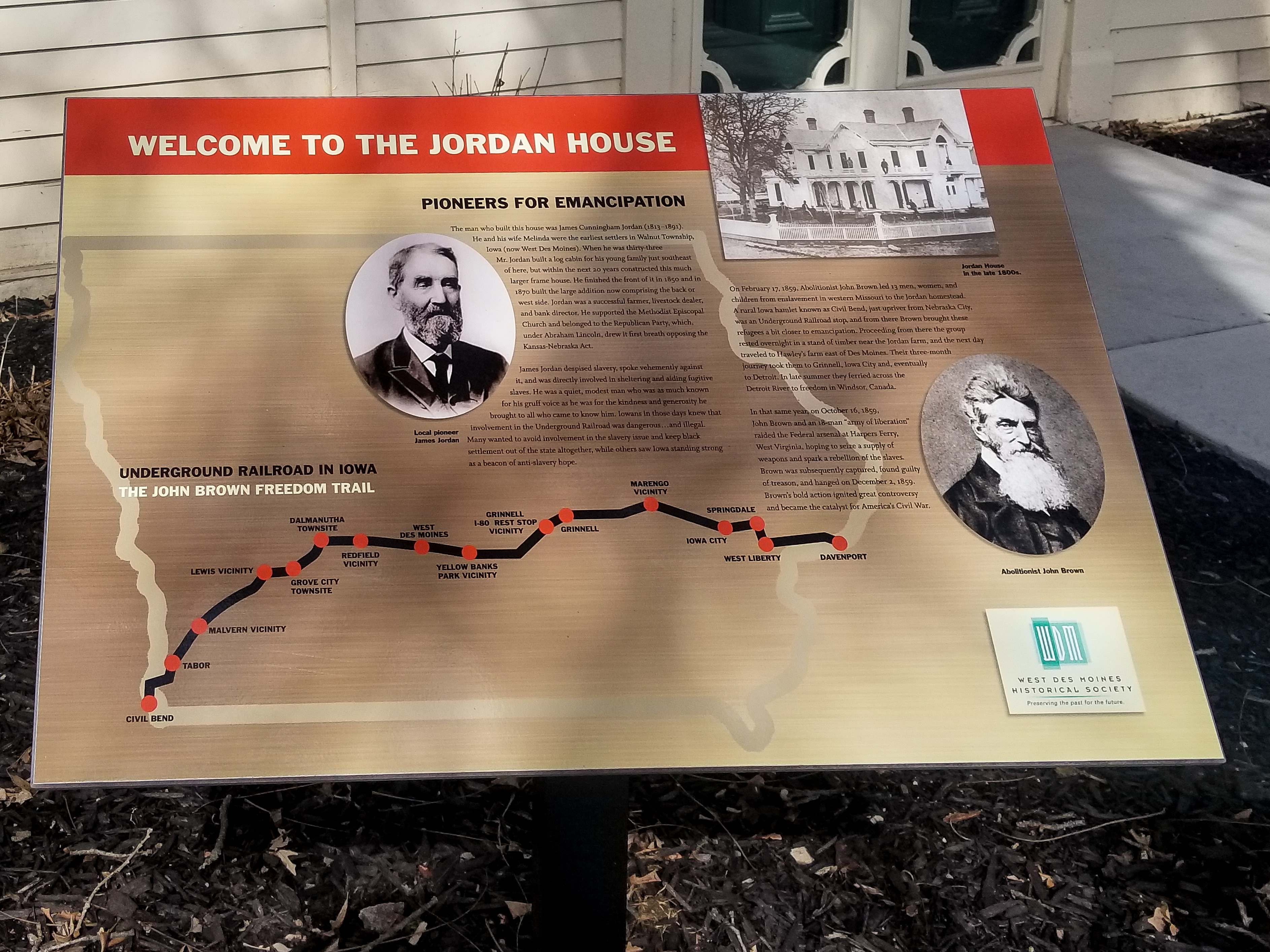
Meet Iowa Farmer James Jordan, Underground Railroad Conductor
Some call them upstanders. Others call them allies. These courageous people are the ones who stand up to help those being oppressed, even at the risk of their own safety. In frontier Iowa, James Jordan fearlessly helped Freedom Seekers gain safe passage on the Underground Railroad route that passed near his farm in the area that would become West Des Moines.
The Underground Railroad ran across the southern and central regions of Iowa, a state where slave ownership was never legal. This impacted pioneer farmer J Jordan (1813-1891) and his wife, Melinda, some of the earliest settlers in Polk County’s Walnut Township. The land they once owned includes the stately Jordan House, which is located along Fuller Road in West Des Moines. The Jordan’s farm harbored fugitive slaves during the tense days leading up to America’s Civil War. Such daring deeds, however, weren’t always part of the Jordan family’s history.
Jordan was born in in 1813 in what is now West Virginia, in a community where slavery was ingrained in society and culture. Jordan, a cattle farmer, was expected to assist family members and neighbors in their hunt for escaped slaves. Jordan’s branch of the family, however, was influenced by a religious movement called “The Great Awakening” that was sweeping the country and opposed slavery. These experiences developed Jordan’s abolitionist beliefs and zeal, especially as he moved westward.

Jordan House, West Des Moines
Building a new life in central Iowa
As treaties were signed between the U.S. government and the Indian tribes that agreed to move out of the Iowa territory by the mid-1840s, pioneers like Jordan were ready to move in. After Jordan settled in the Walnut Township area of Polk County, he chose a beautiful location with ancient oak, walnut and hickory trees on land gently sloping to the Raccoon River. Jordan’s first shelter was a lean-to tent, which he replaced in 1848 with a log cabin.
In 1850, Jordan and his wife, Melinda, began work on the first phase of a new frame house. The family, which at that time included six children, lived for a time in the basement, which included a small kitchen and a bedroom/sitting room.
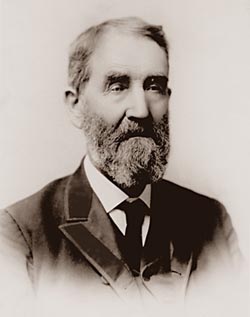
James Jordan
Aiding the Meskwaki
Jordan became a successful farmer, livestock dealer and bank director. Though Jordan’s dream was to develop and manage a financially successful livestock business, he remained deeply committed to helping others achieve their dreams, as well. He supported the Methodist Episcopal Church and belonged to the new Republican Party, which included many members who opposed the Kansas-Nebraska Act that Congress passed in 1854.
The Kansas-Nebraska Act allowed people in the territories of Kansas and Nebraska to decide for themselves whether or not to allow slavery within their borders. The Act repealed the Missouri Compromise of 1820, which prohibited slavery north of latitude 36°30´. The Kansas-Nebraska Act infuriated many in the North, who considered the Missouri Compromise to be a long-standing, binding agreement. There was strong support for the Kansas-Nebraska Act, however, in the pro-slavery South.
Pro-slavery and anti-slavery supporters rushed in to settle Kansas and impact the outcome of the first election held there after the law went into effect. Violence soon erupted, with the anti-slavery forces led by the radical abolitionist John Brown. The territory earned the nickname “bleeding Kansas” as the death toll rose.
Back in Iowa, many citizens wanted to avoid involvement in the slavery issue and keep black settlement out of the state altogether, while others saw Iowa standing strong as a beacon of anti-slavery hope. When Jordan was elected to the Iowa Senate in the mid-1850s, he was able to make a difference Sen. Jordan and his colleagues in the Iowa State Legislature helped the Meskwaki Indians achieve their dream of regaining the land they had lost in Iowa.
Speaking out against slavery
While Jordan was described as a quiet, modest man who was widely-known for the kindness and generosity he showed to all who came to know him, he despised slavery and spoke out vehemently against it. Jordan was actively engaged in the abolitionist movement locally, becoming the “chief conductor” of the Underground Railroad in Polk County. Jordan knew that involvement in the Underground Railroad was dangerous and illegal. Nevertheless, he became directly involved in sheltering and aiding fugitive slaves from his Walnut Township farm.
At the state level, Jordan promoted the anti-slavery Republican Party, and on the national level he befriended the radical abolitionist John Brown. Brown stayed at the Jordan House at least twice, the last time in 1859 when he was leading a group of 12 slaves he had recently liberated in Missouri to freedom in Canada.
On February 17, 1859, Brown led 13 men, women and children who had been enslaved in western Missouri to the Jordan homestead. The small group had begun their journey at a rural Iowa hamlet known as Civil Bend, an Underground Railroad stop just upriver from Nebraska City, Nebraska. From there, Brown brought the refugees a bit closer to emancipation. As they neared central Iowa, the group rested in a stand of timber near the Jordan farm.
(While people on the Underground Railroad stopped at the Jordan family’s property, they most likely never set foot in the actual home. Jordan was one of the largest land owners in the state, plus there were barns and outbuildings on his property, so it didn’t make much sense for freedom seekers to hide in the basement of the Jordan family’s home, according to the West Des Moines Historical Society in a 2018 interview with Des Moines TV station WHO Channel 13.)
After leaving the Jordan farm, the group of freedom seekers traveled the next day to a place called Hawley’s farm east of Des Moines. Their three-month journey took to them to Grinnell, Iowa City and eventually to Detroit, Michigan. In the late summer of 1859, the group ferried across the Detroit River to freedom in Windsor, Canada.
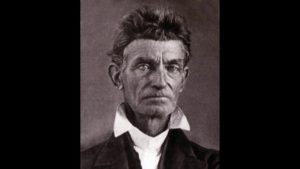
John Brown
Just a few months later, on October 16, 1859, John Brown and an 18-man “army of liberation” raided the federal arsenal at Harpers Ferry, West Virginia, hoping to seize a supply of weapons and spark a rebellion of slaves. Brown was subsequently captured, found guilty of treason, and hanged on December 2, 1859.
It’s interesting to note that Brown’s connections to James Jordan weren’t his only ties to rural Iowa settlers. One line of the Underground Railroad crossed the Raccoon River in southern Dallas County. Fugitive slaves in the 1850s sometimes traveled this route to the “Quaker Divide” northeast of Dexter. Many local members of the Society of Friends (Quakers) supported anti-slavery efforts.
Some residents, like Harmon Cook, were conductors on the Underground Railroad. When Brown was in the Dexter-Redfield area before his 1859 raid on Harper’s Ferry, he admonished Cook after the conductor almost got caught going to Des Moines with fugitive slaves. “Young man, never do so rash a thing as to talk and laugh out loud on the way.”
While no one knows for sure how many slaves reached freedom on the Underground Railroad, historians estimate that 1,000 slaves per year made the attempt. Most who tried did not have the benefit of someone like John Brown or Harriet Tubman to guide them along the journey and were not successful.
Seeking the north star of freedom
Jordan’s role in the Underground Railroad has been honored for generations. “The History of Polk County,” published in 1880, stated that “Jordan has been a life-long enemy of slavery; his devotion to the political life as a staunch and stalwart Republican is the outgrowth of deep-seated conviction; it is among the pleasant things to remember, that under his protecting roof John Brown and his associates, with more than a score of recently liberated slaves, have offered their prayers and sung their first jubilee hymns on their way to Canada….”
Jordan passed away in 1891, but his story lives on. Today, the Jordan House, a stately Victorian home of Italianate Gothic design, is one of the oldest structures in Polk Country and is one of the few locations in Iowa where visitors can tour the home of an Underground Railroad conductor. The home is listed on the National Register of Historic Places and is part of the National Underground Railroad Network to Freedom Program.
Perhaps Jordan’s legacy was best summarized by Jordan’s pastor, who eulogized him by stating, “In the days of slavery this great heart reached out and helped the oppressed, seeking the north star of freedom.”
Click here to learn more if you’d like to plan a visit the Jordan House in West Des Moines.
Want more?
This story is an excerpt from my book Iowa Agriculture: A History of Farming, Family and Food. Click here to learn more and order a signed copy here.
I invite you to read more of my blog posts if you value intriguing Iowa stories and history, along with Iowa food, agriculture updates, recipes and tips to make you a better communicator.
If you’re hungry for more stories of Iowa history, check out my top-selling “Culinary History of Iowa: Sweet Corn, Pork Tenderloins, Maid-Rites and More” book from The History Press. Also take a look at my other books, including “Iowa Agriculture: A History of Farming, Family and Food” from The History Press, “Dallas County” and “Calhoun County” book from Arcadia Publishing. All are filled with vintage photos and compelling stories that showcase the history of small-town and rural Iowa. Click here to order your signed copies today! Iowa postcards are available in my online store, too.
If you like what you see and want to be notified when I post new stories, be sure to click on the “subscribe to blog updates/newsletter” button at the top of this page, or click here. Feel free to share this with friends and colleagues who might be interested, too.
Also, if you or someone you know could use my writing services (I’m not only Iowa’s storyteller, but a professionally-trained journalist with 20 years of experience), let’s talk. I work with businesses and organizations within Iowa and across the country to unleash the power of great storytelling to define their brand and connect with their audience through clear, compelling blog posts, articles, news releases, feature stories, newsletter articles, social media, video scripts, and photography. Learn more at www.darcymaulsby.com, or e-mail me at yettergirl@yahoo.com.
Let’s stay in touch. I’m at darcy@darcymaulsby.com, and yettergirl@yahoo.com.
Talk to you soon!
Darcy

Long Live Print Newsletters! 5 Keys to Content Marketing Success
Notice the farmer said he doesn’t see the name John Deere popping up all over the stories in the magazine. If fact, it’s extremely rare. There’s a reason why. People know when they’re being sold.
If this sounds good, you might be wondering next steps. If you already have a newsletter program, how do you keep it going? If you had one but dropped it, how do you revive it? What if your company never had a newsletter program?
1. Add value. The #1 secret of any successful content marketing, including print marketing, is to add value for your audience. The easiest way to find good story ideas that add value? Become a detective. Ask your co-workers to provide answers to timely questions they are hearing from their clients and prospects. Don’t forget to have them think about the questions they think clients and prospects should be asking but aren’t. Then have your team provide the answers, which make a great foundation for newsletter content.
I know you still may have a lot more questions about content marketing or a print newsletter program. If so, let’s start the conversation.
Want more?
I invite you to read more of my blog posts if you value intriguing Iowa stories and history, along with Iowa food, agriculture updates, recipes and tips to make you a better communicator.
If you’re hungry for more stories of Iowa history, check out my top-selling “Culinary History of Iowa: Sweet Corn, Pork Tenderloins, Maid-Rites and More” book from The History Press. Also take a look at my other books, including “Iowa Agriculture: A History of Farming, Family and Food” from The History Press, “Dallas County” and “Calhoun County” book from Arcadia Publishing. All are filled with vintage photos and compelling stories that showcase the history of small-town and rural Iowa. Click here to order your signed copies today! Iowa postcards are available in my online store, too.
If you like what you see and want to be notified when I post new stories, be sure to click on the “subscribe to blog updates/newsletter” button at the top of this page, or click here. Feel free to share this with friends and colleagues who might be interested, too.
Also, if you or someone you know could use my writing services (I’m not only Iowa’s storyteller, but a professionally-trained journalist with 20 years of experience), let’s talk. I work with businesses and organizations within Iowa and across the country to unleash the power of great storytelling to define their brand and connect with their audience through clear, compelling blog posts, articles, news releases, feature stories, newsletter articles, social media, video scripts, and photography. Learn more at www.darcymaulsby.com, or e-mail me at yettergirl@yahoo.com.
Let’s stay in touch. I’m at darcy@darcymaulsby.com, and yettergirl@yahoo.com.
Talk to you soon!

The Corn Lady: Jessie Field Shambaugh and the Birth of 4-H in Iowa
Well-behaved women rarely make history. At a time when young girls in rural Iowa generally weren’t encouraged to broaden their knowledge of agriculture, Jessie (Field) Shambaugh chose to attend educational farm meetings with her father by the time she was 12 years old. She went on to become one of the first female ag teachers in the nation. By the time she was 24, she was elected superintendent of schools for Page County, Iowa. “The Corn Lady,” as she was affectionately known, also helped guide the formation of an innovative new learning opportunity that endures today–4-H–with the goal to “make the best better.”
Farm women have long broken new ground in rural Iowa. Jessie Field Shambaugh (sister of the famous nursery and garden innovator Henry Field) guided the formation of today’s 4-H clubs during her tenure as a country schoolteacher in southwest Iowa.
Born in 1881 on a farm near Shenandoah, Shambaugh started her career teaching taught country school in southwest Iowa. By the turn of the twentieth century, “Miss Jessie” was a woman far ahead of her time. An innovative teacher, she introduced basic science classes in addition to the “3 Rs” in the country school curriculum. She believed in teaching country children in terms of country life and was a strong proponent of relating school lessons more closely to life on the farm and in the rural home.
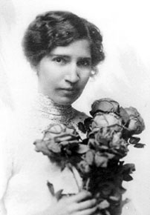
Jessie Field Shambaugh of Iowa
By developing the Boys’ Corn Club and the Girls’ Home Club, Miss Jessie created the forerunner of 4-H and became the first female ag teacher in the nation. Her knowledge of agriculture was extensive, as her father had encouraged her to learn about farming methods from the time she was a young girl. As early as age twelve, Miss Jessie attended local Farmers’ Institute meetings with her father and listened to presentations from ag leaders like “Uncle Henry” Wallace, who edited Wallaces’ Farmer.
Inspired by these ideas, Miss Jessie promoted hands-on, practical learning. She pioneered a powerful educational concept to help young people learn “to make the best better.” By age twenty-four, Miss Jessie had been elected superintendent of schools for Page County. She was one of the first female county superintendents in Iowa.
Starting in 1906, she enlisted the assistance of the 130 one-room country schools in the county to form boys’ and girls’ clubs. Miss Jessie encouraged the young people to participate in judging contests. She believed that friendly competition inspired students to excel. At the Junior Exhibits held at the Farmers’ Institute in Clarinda, entry classes for students included “Best 10 Ears of Yellow Dent Corn,” “Best Device Made by a Boy for Use on the Farm” and “Best 10 Ears of Seed Corn Selected by a Girl.”
Miss Jessie’s efforts gained national attention from educators and reporters. She hosted the U.S. Commissioner of Education and state superintendents as they toured Page County clubs in 1909. She designed the 3-leaf clover pin to reward 3-H project winners and wrote the Country Girls Creed. Jessie Field Shambaugh’s vision and pioneer spirit led to 4-H clubs nationwide, notes the Iowa 4-H Foundation.

4H logo
The goal was to “make the country life as rewarding as it might be in any other walk of life,” Miss Jessie noted in The Very Beginnings. While she passed away at age 90 in 1971, Shambaugh was inducted into the Iowa Women’s Hall of Fame in 1977, and her legacy lives on.
“My mother always wanted to help the farm boys and girls,” said Miss Jessie’s daughter, Ruth Watkins of Clarinda, whom I interviewed in 2002. “She had great idealism and was able to carry it through to reality.”
This is the spirit that inspired me to post this on March 8–International Women’s Day (IWD). I’ve long been inspired by rural Iowa women like Miss Jessie, who were breaking new ground as they became a force for good in their local community, long before the first IWD, which dates back to 1911. I think Miss Jessie would agree with the IWD’s philosophy that “We are all parts of a whole. Our individual actions, conversations, behaviors and mindsets can have an impact on our larger society.”
Want more?
Thanks for stopping by. Miss Jessie’s story is just one of the remarkable women featured in Chapter 9, “Iowa Women Blaze New Trails in Agriculture,” in my upcoming book Iowa Agriculture: A History of Farming, Family and Food, which will be release on April 27, 2020, by The History Press.
In the meantime, I invite you to read more of my blog posts if you value intriguing Iowa stories and history, along with Iowa food, agriculture updates, recipes and tips to make you a better
If you’re hungry for more stories of Iowa history, check out my top-selling “Culinary History of Iowa: Sweet Corn, Pork Tenderloins, Maid-Rites and More” book from The History Press. Also take a look at my latest book, “Dallas County,” and my “Calhoun County” book from Arcadia Publishing. Both are filled with vintage photos and compelling stories that showcase he history of small-town and rural Iowa. Order your signed copies today! Iowa postcards are available in my online store, too.
If you like what you see and want to be notified when I post new stories, be sure to click on the “subscribe to blog updates/newsletter” button at the top of this page, or click here. Feel free to share this with friends and colleagues who might be interested, too.
Also, if you or someone you know could use my writing services (I’m not only Iowa’s storyteller, but a professionally-trained journalist with 20 years of experience), let’s talk. I work with businesses and organizations within Iowa and across the country to unleash the power of great storytelling to define their brand and connect with their audience through clear, compelling blog posts, articles, news releases, feature stories, newsletter articles, social media, video scripts, and photography. Learn more at www.darcymaulsby.com, or e-mail me at yettergirl@yahoo.com.
Let’s stay in touch. I’m at darcy@darcymaulsby.com, and yettergirl@yahoo.com.
Talk to you soon!
Darcy
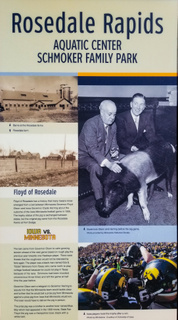
Iowa’s “Peacemaker Pig” Floyd of Rosedale Helped Calm Racial Tensions
If you follow college football in the Midwest, especially if you’re a University of Iowa Hawkeye football fan, you may know the story of Floyd of Rosedale. A bronze statue of the pig, Floyd of Rosedale, is exchanged between the two states. The original pig himself came from Rosedale Farms at Fort Dodge in north-central Iowa.
The whole deal emerged from a bet between Iowa Governor Clyde Herring and Minnesota Governor Floyd Olson about the outcome of the 1935 Iowa-Minnesota football game, but this story involves something much deeper than a famous pig and a bronze trophy.
The problem started the previous year, on Saturday, October 27, 1934, when rough play was directed towards one Iowa Hawkeye running back, Ozzie Simmons. Simmons was a rarity in that era: a black player on a major college football team. Dubbed the “ebony eel” by some sportswriters of the era, Simmons had come north to play football when he wasn’t allowed to play football in his home state of Texas, due to his race.
America in the 1930s included Jim Crow laws in southern states, which segregated blacks from whites. In northern states, no such laws existed, but discrimination was still widespread.
Simmons’ talent couldn’t be denied, however, and he attracted the attention of a young Iowa sports broadcaster perched high above the field. That broadcaster, who would become President Ronald Reagan, became an Ozzie Simmons fan, noted Minnesota Public Radio (MPR), which aired the story “The Origin of Floyd of Rosedale” in 2005. Reagan described a trademark Simmons’ move during a telephone interview with legendary Iowa sports broadcaster Jim Zabel of WHO Radio in Des Moines.
“Ozzie would come up to a man, and instead of a stiff-arm or sidestep or something, Ozzie — holding the football in one hand — would stick the football out,” Reagan said. “And the defensive man just instinctively would grab at the ball. Ozzie would pull it away from him and go around him.”
There were no dazzling runs against Minnesota, however, in the 1934 game at Iowa. Simmons was knocked out three times, leaving the game for good by halftime. The Gophers overwhelmed Simmons and the rest of the Iowa team, beating them 48-12.
While Minnesota went on to win the national championship that year, Iowa fans at the game were outraged by how Minnesota played, in Iowa City claiming the defense deliberately went after Iowa Simmons hard. (Just 11 years earlier, Iowa State’s first black athlete, Jack Trice, died of injuries sustained in a game at Minnesota in 1923.)
How Floyd of Rosedale was born
In 1935, the Rosedale Trophy debuted in an attempt to generate some goodwill between the two schools. Ahead of the 1935 game, Herring warned Minnesota not to pull the same stunts it did the year before. “If the officials stand for any rough tactics like Minnesota used last year, I’m sure the crowd won’t,” Herring said.
Olson sent a telegram to Governor Herring to assure him that the Minnesota team would tackle clean. To help calm the growing tension ahead of the next Minnesota-Iowa football game, Olson also went on to say that he would bet a prize pig from Minnesota against a prize pig from Iowa that Minnesota would win the big game. The loser would have to deliver the pig in person.
“Dear Clyde,” stated Olson’s telegram to Herring. “Minnesota folks are excited over your statement about the Iowa crowd lynching the Minnesota football team. If you seriously think Iowa has any chance to win, I will bet you a Minnesota prize hog against an Iowa prize hog that Minnesota wins today.”
The Iowa governor accepted, and what became known as the Floyd of Rosedale prize was born. Herring apparently followed Olson’s cue. He joked it would be hard to find a prize hog in Minnesota, since they all were so “scrawny.”
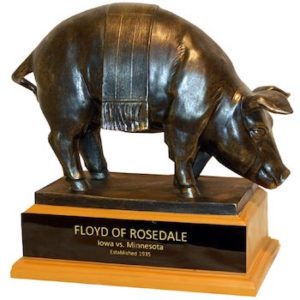
Floyd of Rosedale trophy
Word of the bet reached Iowa City as the crowd gathered at the stadium. Things calmed down, and the game proceeded without incident. Minnesota won 13-7.
The prize pig from Iowa was a Hampshire boar, black with a white belt. He was later named the Floyd of Rosedale after Minnesota’s governor. In the week following the big game, Herring delivered the live pig to the Minnesota Capitol building in St. Paul and took Floyd inside to meet Olson.
After the hog’s trophy days were over, Floyd spent his remaining days on a farm in southeast Minnesota. Floyd died of hog cholera in July 1936, about eight months after he made the front page. The real Floyd, Governor Olson, passed away less than a month later, dying of cancer in August 1936.
(Ironically, Floyd the hog wasn’t the only celebrity in his family. Floyd of Rosedale was the brother of another famous boar, Blue Boy, who had appeared in the 1933 movie “State Fair.”)
Leaving a legacy
All these years later, the famous Floyd of Rosedale endures as one of college football’s most famous trophies. Floyd of Rosedale’s legacy is also preserved in a marker by the Rosedale Rapids Aquatic Center in Fort Dodge.
Simmons, whose story prompted the Floyd of Rosedale trophy, never took much interest in the trophy, in part because of the era of racial discrimination it recalled. He was denied a chance to play professional football, because the National Football League banned black players at the time, noted MPR. He played some minor league ball, joined the Navy and eventually became a Chicago public school teacher.
“When Ozzie Simmons stepped onto the field in October, 1934, to play Minnesota, he entered a national drama that’s still playing out today,” MPR noted. “All Simmons wanted was a chance. The trophy is an ever-present reminder of how precious that right is.”
Want more stories like this?
These are the kinds of stories I’m sharing in my new book, “Iowa Agriculture: A History of Farming, Family and Food,” which was released by The History Press on Monday, April 27, 2020. Order your signed copy by clicking here to my online store.
One more thing–the story of illegal gambling
After I posted this story, I received this intriguing email from my friend Victoria Herring of Des Moines:
“You may remember coming to Artisan Gallery 218 to do book talks. I was reading your website about the Floyd of Rosedale story – apparently appearing in an upcoming book. I assume you know there’s a bit more to the story == I think George Mills wrote about it in one of his books == when this happened some guy [whose name I forget but he was a bit of a thorn in the side of some public figures] filed a criminal complaint against Gov. Herring [he was my grandfather] alleging illegal betting — might be an interesting even if a little off topic addition.”
I pulled out a copy of George Mills’ classic book, Looking in Windows: Surprising Stories of Old Des Moines, and saw exactly what Victoria was talking about. In the second called “A Governor Arrested,” Mills explained how a gadfly named Virgil Case in Des Moines got a warrant for Governor Herring’s arrest following the Floyd of Rosedale 1935 bet. The charge? Gambling on a hog wager.
At the time, Iowa law provided a penalty of up to a $100 fine or 30 days in jail for gambling. Municipal Judge J.E. Mershon signed the warrant.
Who was Case and why did he go to all this trouble? He was a “natural-born hell raiser,” wrote Mils, who added that Case had been a secretary to a Des Moines mayor and publisher of a weekly newspaper.
Case explained how he happened to file the charge. He said he had some spare time, and it occurred to him a “good way to put in that time was to go over to Municipal Court and have the governor arrested. So that’s what I did.” He said his profession was “raising hell with public officials because they should be the first to set a good example.”
Word of the warrant reached Herring while he was still with Minnesota Governor Olson in Minneapolis. Herring immediately engaged Olson as his attorney. Olson squelched a suggestion that the pig be auctioned off to pay a possible Herring fine. “That pig stays in Minnesota, regardless of what happens,” Olson declared. He added that the bet wasn’t a gamble anyway, since Minnesota was a cinch to win the game.
Olson suggested that Herring stay in St. Paul, where he couldn’t be extradited, since the Minnesota governor had to consent to the extradition, and Olson was already Herring’s attorney. Herring observed that only the governor of Iowa could extradite anyone back to Iowa–and he was the governor of Iowa.
“Olson added a sly insult when he said it wasn’t gambling because ‘nothing of value was involved,'” Mills wrote. Herring shot back that Floyd of Rosedale was a “right good hog.”
Walter Brick, deputy municipal court bailiff, cause a stir of excitement at the Iowa statehouse a few days later. When he showed up at Herring’s office, reporters thought maybe he was there to lead the governor away in handcuffs. Nope. Brick just wanted to talk over a planned court hearing on the charge.
The only action the deputy took that day was to join the reporters in eating apples out of Herring’s fruit basket. (“Beside apples, Herring was known at times to shut the door and provide the press with beer and Pella bologna, something no governor has done since,” Mills wrote.)
In the hearing, reporters and others testified that Herring hadn’t committed the so-called offense in Des Moines, that the bet wasn’t complete until Herring and Olson met in Iowa City. Assistant Polk County Attorney C. Edwin Moore, later chief justice of the Iowa Supreme Court, moved that the case be dismissed. Judge Mershon was glad to do so. “The folderol was over,” Mills concluded.
Want more?
Thanks for stopping by. I invite you to read more of my blog posts if you value intriguing Iowa stories and history, along with Iowa food, agriculture updates, recipes and tips to make you a better
If you’re hungry for more stories of Iowa history, check out my top-selling “Culinary History of Iowa: Sweet Corn, Pork Tenderloins, Maid-Rites and More” book from The History Press. Also take a look at my latest book, “Dallas County,” and my “Calhoun County” book from Arcadia Publishing. Both are filled with vintage photos and compelling stories that showcase he history of small-town and rural Iowa. Order your signed copies today! Iowa postcards are available in my online store, too.
If you like what you see and want to be notified when I post new stories, be sure to click on the “subscribe to blog updates/newsletter” button at the top of this page, or click here. Feel free to share this with friends and colleagues who might be interested, too.
Also, if you or someone you know could use my writing services (I’m not only Iowa’s storyteller, but a professionally-trained journalist with 20 years of experience), let’s talk. I work with businesses and organizations within Iowa and across the country to unleash the power of great storytelling to define their brand and connect with their audience through clear, compelling blog posts, articles, news releases, feature stories, newsletter articles, social media, video scripts, and photography. Learn more at www.darcymaulsby.com, or e-mail me at yettergirl@yahoo.com.
Let’s stay in touch. I’m at darcy@darcymaulsby.com, and yettergirl@yahoo.com.
Talk to you soon!
Darcy
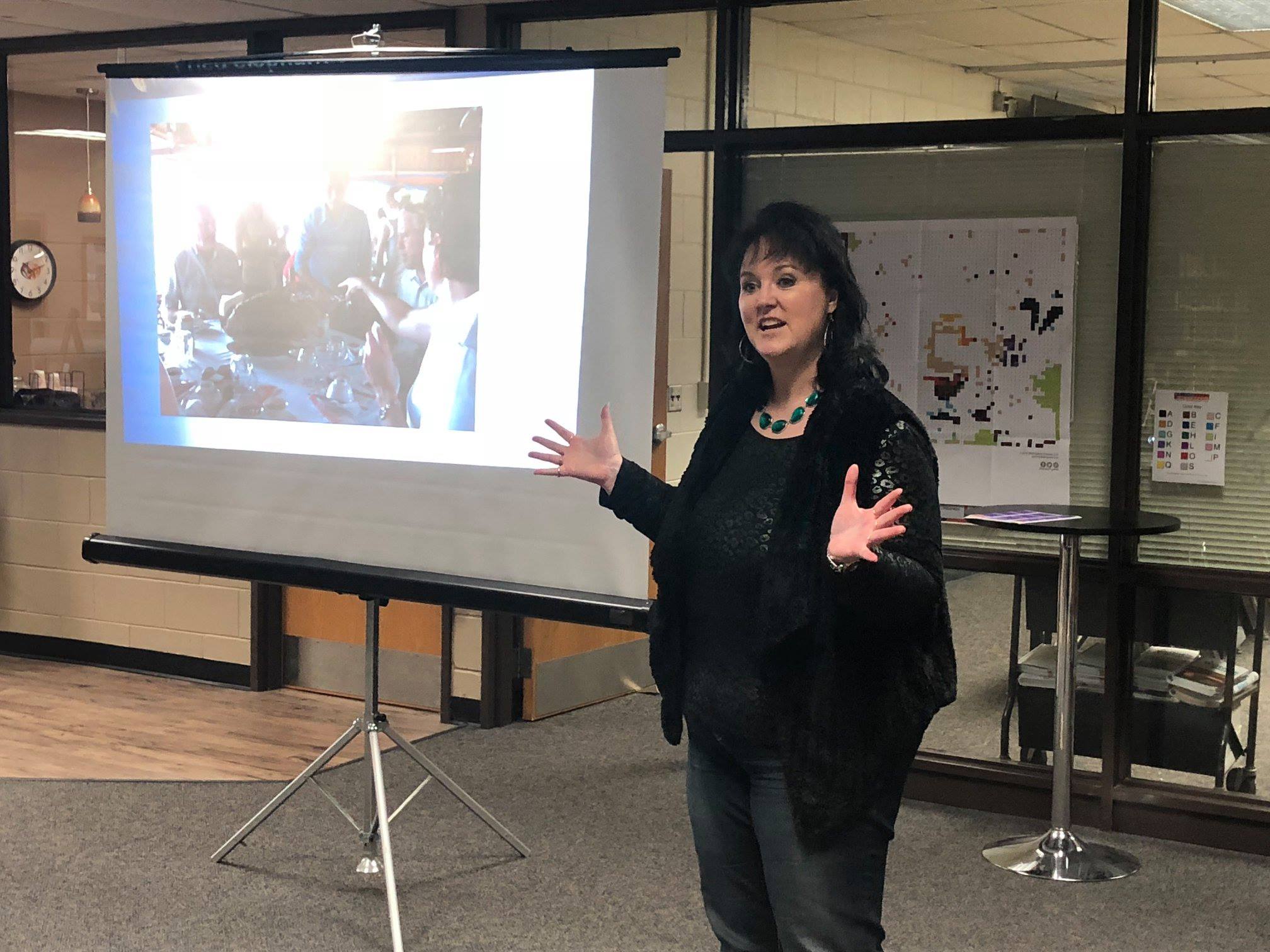
Why We Should Never Stop Asking Why
Ever been asked to speak at career day at the local middle school? If you haven’t, trust me when I say it’s an eye-opening, slightly nerve-wracking experience.
I volunteered with the Calhoun County Farm Bureau to speak at Ag Day on March 26 at the Manson Northwest Webster Middle School about my travels to Vietnam and South Korea a few years ago with the Iowa Corn Growers’ I-LEAD leadership group.
Then I headed west to Sac City on March 29 to share my “True Confessions of an Ag Journalist” program during the Sac County Farm Bureau’s I Am Ag career day, where professionals from veterinarians to bankers spoke about the pros and cons of their careers.
Throughout the day, each speaker is assigned a classroom, and we share our story 12 times in 25-minute segments. I always go home from these events exhausted, but I hope I added value for the students and helped spark their desire to keep learning.
What always amazes me is how different the response is from the sixth graders to the eighth graders. The sixth graders are excited to learn and have no fear of asking questions. In fact, many of them are quick to raise their hands to ask questions and share comments.
Everything changes when the eighth graders walk in the room. Many of these kids want to show you just how bored they are. Some convey clearly through their body language and comments that don’t want to be stuck in a classroom. Their eyes tell you in no uncertain terms that they’re just waiting to defy anyone who dares to challenge them to think and learn.
Undaunted, I tell every group of students I work with that one of the keys to being a successful writer/storyteller/journalist (or any leader, for that matter) is to be like the little kid who never stopped asking why. Always nurture your sense of wonder and curiosity. Not only is that how we learn, but it makes life more fun!
Why do we lose the why?
This experience made me wonder why so many people lose their desire to ask questions.
A Newsweek story, “The Creativity Crisis,” described the signs of declining creativity among our school children. The article noted that preschool kids ask their parents an average of 100 questions a day. WOW! By middle school, however, kids basically stop asking questions.
It is also around this time student motivation and engagement drop like a rock. Why? Our educational system tends to reward students for having the answer, not for asking good questions. Ask a question, and you risk looking ignorant.
Yet knowing how to ask the right questions in the right way is essential to career success, more enjoyable conversations, stronger interpersonal relationships and effective leadership. I can only tell compelling, clear stories for my clients and through my books when I ask the right questions.
 Questions I use
Questions I use
I often work from a tried-and-true, proven set of open-ended questions that encourage sources to open up so we can go beyond the superficial and dig deeper to get to the good stuff—the defining moments, the setbacks, and the dreams that add life and vitality to any story.
Here are some of my key questions
1. What’s some of the best business advice—or advice for life—you’ve ever received?
2. What’s your motivation (for your work, or your life)?
3. What three things inspire you? (These can be people, books, movies, art, places, etc.)
4. What three words describe you?
5. What three words describe your company?
6. What’s something odd/interesting/unique about you? (This fun fact should not be so personal you would only share it with a therapist, but also not so safe it will bore us!)
7. How did you get started in the business you’re in?
8. Think back to when you first hit adulthood. What did you think your life would be like? What was your plan A? Are you still with Plan A, or did you move on to Plan B?
9. What obstacles did you overcome to get where you are today?
10. What’s a specific story of success in your business that drives you to do what you do? (A customer that really affected you, a person you were able to help, an accomplishment you were able to achieve?)
11. What do you like about your work?
12. What helpful lessons did you learn from previous jobs that you apply to your current role?
13. What’s the weirdest thing that’s ever happened to you at work?
14. What’s the best thing that ever happened to you/you witnessed at work?
15. How did your company get started?
16. What excites you about the future?
You can modify these questions (or create your own) and put them to work in your business, your home or your classroom. Please tell me how it goes, too. Don’t be surprised if I ask you why you think these questions work. I love to learn and hope you do to, too!
No matter what, never stop asking “why” about the world around you. We need more critical thinkers. Also remember the words of playwright George Bernard Shaw: “Some men see things as they are, and ask why. I dream of things that never were, and ask why not.”
Want more?
Thanks for stopping by. I invite you to read more of my blog posts if you value intriguing Iowa stories and history, along with Iowa food, agriculture updates, recipes and tips to make you a better communicator.
If you like what you see and want to be notified when I post new stories, be sure to click on the “subscribe to blog updates/newsletter” button at the top of this page, or click here. Feel free to share this with friends and colleagues who might be interested, too.
Also, if you or someone you know could use my writing services (I’m not only Iowa’s storyteller, but a professionally-trained journalist with 20 years of experience), let’s talk. I work with businesses and organizations within Iowa and across the country to unleash the power of great storytelling to define their brand and connect with their audience through clear, compelling blog posts, articles, news releases, feature stories, newsletter articles, social media, video scripts, and photography. Learn more at www.darcymaulsby.com, or e-mail me at yettergirl@yahoo.com.
If you’re hungry for more stories of Iowa history, check out my top-selling “Culinary History of Iowa: Sweet Corn, Pork Tenderloins, Maid-Rites and More” book from The History Press. Also take a look at my latest book, “Dallas County,” and my Calhoun County” book from Arcadia Publishing. Both are filled with vintage photos and compelling stories that showcase he history of small-town and rural Iowa. Order your signed copies today! Iowa postcards are available in my online store, too.
Let’s stay in touch. I’m at darcy@darcymaulsby.com, and yettergirl@yahoo.com.
Talk to you soon!
Darcy
@Copyright 2019 Darcy Maulsby & Co. Blog posts may only be reprinted with permission from Darcy Maulsby.
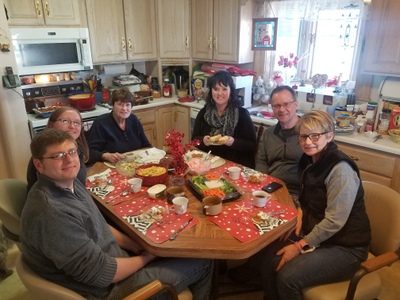
From My Kitchen to Yours: Comfort Food, Conversation and Living History Farms
Ever get an email that jumps out at you? It happened me to last July when one arrived with the subject line “Greetings from Living History Farms.” It was from my friend, Jim Dietz-Kilen, a former classmate from the Ag-Urban Leadership Initiative, and his note intrigued me.
“I have an idea for your consideration,” wrote Jim, who is the vice president of development for Living History Farms (LHF). “We are planning our annual gala, Farmstasia. We try to put together unique experience packages for our auction, with emphasis on agriculture/rural life and Iowa history. My idea is to build a package around you. While I am very open to other ideas, I wanted to run the following request by you:
• Would you be willing to donate a signed book? Any of your books would be wonderful, but I am partial to the Culinary History of Iowa.
• Would you also be willing to host a family at your farm to show them a bit of what your lives are like?
• Finally, would you be willing to serve these guests a meal selected from your book?
I know this is asking a lot, Darcy, but I have learned that you never know until you ask. And, as Wayne Gretzky said, ‘Every shot you don’t take is a miss.'”
By this point, I was already brainstorming menu ideas.
I’m a big fan of LHF, which welcomes between 100,000 and 110,000 each year. This interactive, 500-acre outdoor museum that tells the amazing 300+ year story of how Iowans transformed the fertile prairies of the Midwest into the most productive farmland in the world. As I wrote in this blog for Latham Hi-Tech Seeds, I love how LHF encourages people of all ages to explore Iowa’s rural heritage, including the 1700 Ioway village, the 1850 pioneer farm, the 1875 town of Walnut Hill and the 1900 horse-powered farm.
“All proceeds from Farmstasia go to keep fees low for our education programs, helping make it possible for kids from across the state to come here for school visits and participate in other educational experiences,” Jim continued.
Jim knows what is near and dear to my heart. Iowa agriculture. Books. Classic Iowa farm cooking. LHF. Giving back to the community. Without hesitating, I said yes.

Living History Farms Iowa
Cookstoves, corncobs and storytelling
LHF came into my life in a big way in the summer of 1995, when my college internship led me to the 1900 farm, Flynn mansion and veterinary clinic, where I served as a historical interpreter and looked the part in my Victorian-inspired dresses and bonnets.
That summer changed my life in so many ways. I met my husband through this experience. I also expanded my cooking skills. By the end of the summer, I knew how to light a cookstove with crumpled newspapers and corncobs. I could make homemade noodles with no problem. I could bake cookies in an oven with no temperature gauge, other than the feel of the heat on your hand. I could milk a Jersey cow by hand and churn the cream into butter. I could plan a meal and feed a threshing crew. I could even run a treadle sewing machine and sew my own apron.
Looking back, I was a prepper in training who can live off the grid if I have to.
While I don’t use all those skills today, some have served me well for years, especially the cooking skills, the historical knowledge I gained and the storytelling skills I learned. As a historical interpreter, I was not only working in the kitchen of the 1900 farm fixing a meal, but I interacted with guests. As I shared stories about Iowa farm life in the early 1900s, I learned the importance of listening. I’m still embarrassed when I misunderstood one guest who asked, “Is that a coal stove?” but I heard him say, “Is that a cold stove?” so I replied, “No, it’s a warm one!”
Planning a memorable menu
I was thinking of those experiences last Saturday, February 16, when I delivered on my promise to provide the Farmtasia winning bidders with an authentic Iowa farm meal inspired by my book. I had actually started cooking the night before and then got up early on Saturday morning so I’d get everything done on schedule and have time to visit with my guests.
They pulled in the driveway at my family’s Century Farm near Lake City right on time. It was an honor to host Dave Bubeck, a corn breeder at Corteva Agriscience™ in Johnston; his wife, Denise; and their friends Ben and Michelle Parlett, who also live in the Des Moines area. As we gathered around the table at noon, I served:
• Garden Vegetable Soup
• Homemade Beer Bread
• Iowa Ham Balls
• Glazed Meat Loaf
• Garlic Cheesy Smashed Potatoes
• Relish tray and coleslaw salad
• Homemade apple crisp with Haralson apples grown on our farm
There was something magical happened as we sat in that 100+plus-year-old kitchen, talking farming, food, travel and LHF. Seems like we covered everything, from how to talk about GMOs to what it’s like subscribing to a meal delivery service. Two and a half hours later, when my guests departed, we all agreed it was a great experience—the kind of story-worthy experience that LHF inspires. Even better, we’re staying in touch through social media and my e-newsletter.
And to think it all started with a simple email and a spirit of service. It reminds me of this quote from Orison Swett Marden, who founded SUCCESS magazine in 1897.
“We must give more in order to get more. It is the generous giving of ourselves that produces the generous harvest.”
Let’s get cooking
If you’d like to create a taste of our classic Iowa farm dinner, here are some of my favorite recipes:

Hearty Homemade Vegetable Soup
Hearty Garden Vegetable Soup
I shared this tasty recipe in one my my monthly diary entries in 2018 for the Iowa Food and Family Project.
1 tablespoon olive oil
8 medium carrots, sliced
3 large onions, chopped
5 celery ribs, chopped
1 large green pepper, seeded and chopped
1 garlic clove, minced
2 cups chopped cabbage
2 cups frozen cut green beans (about 8 ounces)
2 cups frozen peas (about 8 ounces)
1 can (15 ounces) corn, or 2 cups fresh sweet corn
1 can (28 ounces) diced tomatoes, undrained
2 bay leaves
2 teaspoons chicken bouillon granules
1-1/2 teaspoons dried parsley flakes
1 tablespoon seasoning salt
1 teaspoon dried marjoram
1 teaspoon dried thyme
1/2 teaspoon dried basil
1/2 teaspoon pepper
7 cups water
1 teaspoon Worcestershire sauce
4 cups V8 vegetable juice
In a stockpot, heat oil over medium-high heat; sauté carrots, onions, celery and green pepper until crisp-tender. Add garlic; cook and stir 1 minute. Stir in remaining ingredients; bring to a boil. Reduce heat; simmer, covered, until vegetables are tender, 1 to 1-1/2 hours. Remove bay leaves.

Best Beer Bread
Best Beer Bread
2 cups self-rising flour
2 1 / 2 tablespoons sugar
1 12-ounce can of beer
Mix all ingredients together. Pour batter into a greased loaf pan. Bake at 350 degrees for 45 to 50 minutes.

Iowa Ham Balls
Iowa Ham Balls
This tasty, classic recipe comes from my friend Val Plagge, who is a wonderful farm cook.
2.5 pounds ham
2 eggs
1 1/2 cups graham cracker crumbs
1 cup milk
1 can tomato soup
3/4 cup brown sugar
1/4 cup white vinegar
1 teaspoon ground mustard
With a food processor, grind ham into small, chopped pieces (or buy ham loaf mix from local grocery store or butcher. This mix usually contains ham and ground pork, and sometimes ground beef, too). Add eggs, graham cracker crumbs and milk. Mix together with your hands, and form fist-sized ham balls. (If the mixture seems a little dry, add 1/4 cup of milk at a time, up to 1 1/2 cups of milk total.) Place ham balls in a greased 9-inch by 13-inch pan. They fit nicely three across and five down.
Mix soup, brown sugar, vinegar and mustard until smooth. Drizzle glaze over the ham balls for the classic ham ball sauce. (Or, if you’re in a rush, drizzle your favorite barbecue sauce over the ham balls.) Bake at 350 Fahrenheit for 1 hour. Yield: 13-15 ham balls
Note: These ham balls freeze well and can be warmed up in a slow cooker, if desired. Ham balls are the perfect Iowa potluck treat!
Cheesy Garlic Mashers
Taking a twist on classic mashed potatoes, this recipe is loaded with flavor and offers the perfect comfort food.
Red Bliss or Yukon gold potatoes (use about one potato per person, although this will depend on the size of the potatoes)
6 garlic cloves (can use less, if you prefer)
Butter, 1 / 2 stick
Cream (use enough to give mashed potatoes the consistency you prefer)
1 carton sour cream (can substitute one carton of chip dip, if you prefer)
1 / 2 cup to 1 cup of Cheddar cheese
Seasoning salt and pepper, to taste
Chives, chopped
Bacon, 2 to 3 slices, fried
Boil potatoes in salted water with peeled, whole garlic cloves. When potatoes are done cooking, drain potatoes and garlic and place in a bowl with butter and cream. Mash together. Add more cream, if necessary, to achieve the consistency you prefer. Mix in sour cream and cheddar cheese. Season to taste with seasoning salt and pepper. Garnish with chopped chives and real bacon bits.

Glazed Meatloaf
Darcy’s Best Brown-Sugar Meatloaf
This recipe was inspired by the meatloaf that caterers prepared on the set in Iowa for the filming for “The Bridges of Madison County.” This is the only meatloaf recipe you’ll ever need!
1 pound ground beef
1 pound ground pork or ground turkey
1 cup herb-seasoned stuffing mix
1 onion, chopped
1 teaspoon salt
1/2 teaspoon freshly-ground pepper
1 teaspoon nutmeg
2 large eggs, lightly beaten
3 / 4 cup milk
2 tablespoons barbecue sauce
1 / 4 cup ketchup
2 tablespoons brown sugar
1 teaspoon dry mustard
Combine beef, pork or turkey, stuffing mix, onion, salt, pepper and nutmeg. In a separate bowl, beat eggs, milk, and barbecue sauce. Add to meat mixture, mixing well. Press into a meatloaf pan sprayed with non-stick cooking spray.
Combine ketchup, brown sugar, and mustard; spread over top of meat loaf. Bake, uncovered, at 350 degrees F for 1 hour and 30 minutes or until a thermometer inserted in the center of the loaf registers 160 degrees. Yield: 6 servings
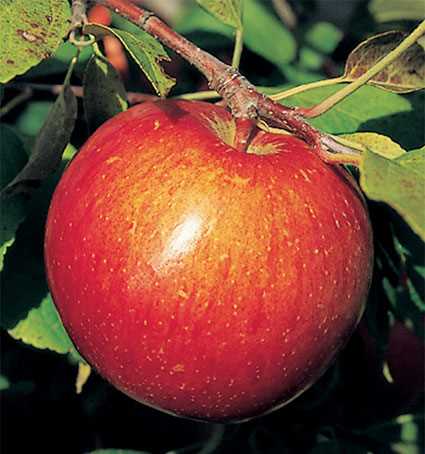
Haralson apple photo from Jung Seed
Farm-Fresh Apple Crisp with Whipped Cream
If you have the chance to visit a local apple orchard, pick up some Haralson apples, if they are available. We grow Haralsons on our farm, and their sweet-tart flavor works perfectly in apple pies and apple crisps.
Fruit Filling:
6 baking apples, peeled, cored and cut into wedges
1 tablespoon lemon juice
1 / 2 cup sugar
2 tablespoons flour (maybe need more, depending on how juicy the apples are)
Crumb topping:
1 1 / 4 cups flour
1 / 2 cup rolled oats
1 / 2 cup light brown sugar
1 / 2 teaspoon ground cinnamon
1 / 4 teaspoon salt
12 tablespoons butter (1 1/2 sticks), cut into small pieces
Preheat the oven to 350 degrees Fahrenheit.
For the fruit filling:
In a large mixing bowl, toss together the apples, lemon juice, sugar, and flour. Pour the apple mixture into a buttered 2-quart baking dish and set aside.
For the topping:
In a large mixing bowl, mix the flour, rolled oats, brown sugar, cinnamon, and salt. With a pastry blender, work the butter into the flour mixture just until mixture comes together and pea-sized clumps form.
Sprinkle the topping evenly over the fruit. Bake the apple crisp until the fruit is bubbling and the topping is golden brown and crisp, about 45 minutes.
Serve the crisp warm with vanilla bean ice cream or fresh whipped cream, if desired.
To make whipped cream, pour 1 cup of whipping cream into metal bowl on stand mixer. (Chill the bowl and whip attachment in the refrigerator first.) Begin mixing on high speed. As the cream starts to form into whipped cream, add powdered sugar a tablespoon at a time, until you achieve the sweetness you desire. Continue mixing on high until the mixture looks like thick whipped cream. Serve with apple crisp.
Want more?
Thanks for stopping by. I invite you to read more of my blog posts if you value intriguing Iowa stories and history, along with Iowa food, agriculture updates, recipes and tips to make you a better communicator.
If you like what you see and want to be notified when I post new stories, be sure to click on the “subscribe to blog updates/newsletter” button at the top of this page, or click here. Feel free to share this with friends and colleagues who might be interested, too.
Also, if you or someone you know could use my writing services (I’m not only Iowa’s storyteller, but a professionally-trained journalist with 20 years of experience), let’s talk. I work with businesses and organizations within Iowa and across the country to unleash the power of great storytelling to define their brand and connect with their audience through clear, compelling blog posts, articles, news releases, feature stories, newsletter articles, social media, video scripts, and photography. Learn more at www.darcymaulsby.com, or e-mail me at yettergirl@yahoo.com.
If you’re hungry for more stories of Iowa history, check out my top-selling “Culinary History of Iowa: Sweet Corn, Pork Tenderloins, Maid-Rites and More” book from The History Press. Also take a look at my latest book, “Dallas County,” and my Calhoun County” book from Arcadia Publishing. Both are filled with vintage photos and compelling stories that showcase he history of small-town and rural Iowa. Order your signed copies today! Iowa postcards are available in my online store, too.
Let’s stay in touch. I’m at darcy@darcymaulsby.com, and yettergirl@yahoo.com.
Talk to you soon!
Darcy
@Copyright 2019 Darcy Maulsby & Co. Blog posts may only be reprinted with permission from Darcy Maulsby.
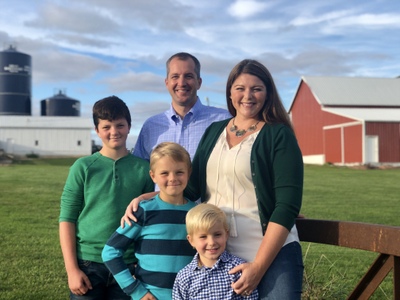
We Need FFA: Iowa Ag Secretary Mike Naig Reflects on His FFA Experiences
When you look at his formative years, my friend Mike Naig shouldn’t be where he is today, serving as Iowa’s Secretary of Agriculture. Even for him, it’s hard to shake memories of the Farm Crisis.
“As a child of the 1980s, I knew my parents didn’t want us to go through the same hardships they did,” said Naig, 40, the third of four Naig children who grew up on their family’s farm near Cylinder in northwest Iowa. “There was this mentality of ‘go do something other than farming,’ so my siblings and I were going to college and pursue careers off the farm.”
Naig considered studying veterinary medicine or a major related to human health. Yet there was something that planted a seed back then in Palo Alto County, something that would take root and shape Naig’s future in ways he could never imagine. That transformative experience was FFA.
“I never predicted I’d serve in a role like this, but I’m grateful for the life skills and ag knowledge I learned in FFA,” said Naig, who is one of Iowa’s most high-profile champions of FFA, especially during National FFA Week from February 16-23, 2019. “We need FFA.”
Naig speaks from experience. Before serving as Iowa’s Secretary of Agriculture, this Buena Vista University graduate worked in agribusiness for more than 13 years, serving in public policy roles for state and national trade associations and in private industry. He served as the Iowa Deputy Secretary of Agriculture under Bill Northey starting in September 2013.
When Northey joined the U.S. Department of Agriculture (USDA), Iowa Governor Kim Reynolds appointed Naig to succeed Northey as Iowa Secretary of Agriculture on March 5, 2018. Naig was elected Secretary of Agriculture in November 2018. Here’s his story:

Iowa Secretary of Agriculture Mike Naig
Q: How did your leadership journey begin?
A: Before I joined FFA, I was heavily involved in 4-H. The first meeting I ever chaired was at my local Independence Boosters 4-H Club. I stayed involved in 4-H through high school and served in all the officer roles. I also served on the 4-H Youth County Council in Palo Alto County. During high school, I went on a leadership trip to Washington, D.C. This helped spark my interest in government and politics.
Q: What role did FFA play in your years at Emmetsburg High School?
A: While I was involved with the student council and served as student body president in high school, I was really into soil judging with FFA. Before I graduated from high school in 1996, our soil judging team made it to state and then to the national competition in Oklahoma. All this fit well with my interest in science, soil quality and soil health. Those of us in FFA were fortunate to have a strong FFA chapter, a great advisor, Jerry Strand, and a supportive community. Although I didn’t know it back then, all this would provide a strong background for my career when I started working on soil and water quality policy issues.
Q: What lessons did you learn from your FFA experiences?
A: FFA teaches you that preparation pays off. The supervised agricultural experience (SAE) challenges you to come up with a project and see it through. This requires you to get organized, plan ahead and think strategically. For many kids, this is one of the first big tastes of responsibility they get. You also learn teamwork, since you have to work together to get things done. Competition is also important in FFA. You learn to put your best effort forward and win with grace. If you come up short, you learn from your mistakes and are encouraged to do better next time.
Q: How can FFA help Iowa meet the challenges of the twenty-first century?
A: FFA does a great job of helping kids learn about the rewarding, ag-related careers that are available in a variety of disciplines right here in Iowa. FFA also does an outstanding job of developing the next generation of ag leaders. This is important, because I see “volunteer fatigue” in many communities. There are plenty of opportunities to serve, including local churches, school boards, county Farm Bureau boards, co-op boards and hospital boards, but it can be hard to replace dedicated board members and volunteers who have served so well for many years. We have significant needs in our rural communities across the state, and we’ll need leaders like those in FFA today to step up and fill these important roles going forward.
Q: What excites you about the future of FFA and Iowa?
A: While these are challenging times in agriculture, there’s always reason for hope. Protein demand worldwide is growing, along with demand for bio-based fuels. Technology continues to advance and create new opportunities. There’s so much we have yet to discover in agriculture, which is exciting!
Iowa is at the epicenter of all this. We have something very special here, and it’s not just our rich soil. It’s our people. Rural Iowa can thrive when it’s guided by lifelong learners who are focused on continuous improvement to protect our precious natural resources and expand economic opportunities. FFA members will be part of this future, guided by the knowledge that feeding people is a noble profession. FFA has a strong record of developing leaders. It’s essential we keep FFA and ag education strong in our schools.
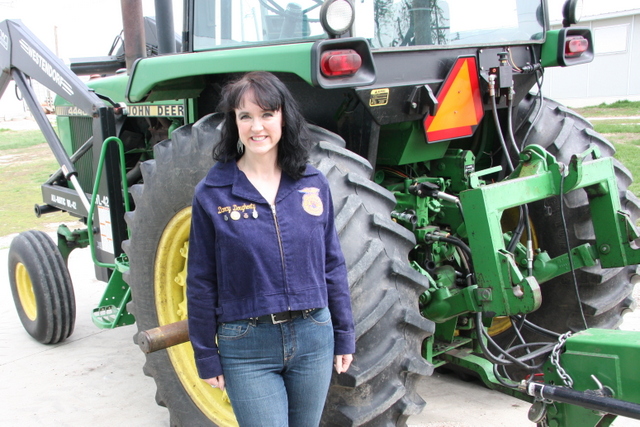
Forever proud to wear the iconic FFA blue jacket!
A note from Darcy:
I appreciate Mike’s comments about the importance of FFA and ag education for this story, which first appeared in Farm News. FFA played a critical role in helping me find my career, but boy, was it a strange, wacky, wonderful journey. Read the whole crazy story here.
Want more?
Thanks for stopping by. I invite you to read more of my blog posts if you value intriguing Iowa stories and history, along with Iowa food, agriculture updates, recipes and tips to make you a better communicator.
If you like what you see and want to be notified when I post new stories, be sure to click on the “subscribe to blog updates/newsletter” button at the top of this page, or click here. Feel free to share this with friends and colleagues who might be interested, too.
Also, if you or someone you know could use my writing services (I’m not only Iowa’s storyteller, but a professionally-trained journalist with 20 years of experience), let’s talk. I work with businesses and organizations within Iowa and across the country to unleash the power of great storytelling to define their brand and connect with their audience through clear, compelling blog posts, articles, news releases, feature stories, newsletter articles, social media, video scripts, and photography. Learn more at www.darcymaulsby.com, or e-mail me at yettergirl@yahoo.com.
If you’re hungry for more stories of Iowa history, check out my top-selling “Culinary History of Iowa: Sweet Corn, Pork Tenderloins, Maid-Rites and More” book from The History Press. Also take a look at my latest book, “Dallas County,” and my Calhoun County” book from Arcadia Publishing. Both are filled with vintage photos and compelling stories that showcase he history of small-town and rural Iowa. Order your signed copies today! Iowa postcards are available in my online store, too.
Let’s stay in touch. I’m at darcy@darcymaulsby.com, and yettergirl@yahoo.com.
Talk to you soon!
Darcy
@Copyright 2019 Darcy Maulsby & Co. Blog posts may only be reprinted with permission from Darcy Maulsby.
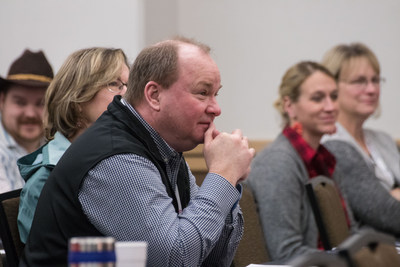
How Not to Invite Someone to Your Next Event–and 3 Solutions
Who’d like to attend another meeting? Not me. You’re probably not looking for another time suck, either. But when you’re the one hosting the meeting, how do you entice people to attend? After all, your meeting is going to be filled with valuable information that will make people glad they stopped by. Don’t miss this!
First, acknowledge the reality of hectic schedules and meeting fatigue—that energy-draining syndrome that infects people who’ve attended one too many unproductive gatherings. I’ve experienced meeting fatigue many a time, and I bet you have, too. That’s why I don’t get overly excited when I get invitations like this:
“It’s time for the XYZ annual meeting! This is your chance to meet with XYZ staff. Find out how area XYZ members are putting our group’s programs to work in their businesses, and see how you can plug in.”
No, thanks. I’ve already got enough on my plate. This invitation isn’t exactly a compelling offer that entices me to mark this event on my calendar. The “benefits” are just too vague.
Don’t waste my time
As a business professional, time is one of my most precious resources. I believe time spent in a meeting (whether it’s in person, online or over the phone) should generate a return on investment. Otherwise, your event isn’t worth it to me, no matter how much I like you or your organization, my friend.
What missed the mark? “Well, wonder no more.”
This is why I just shook my head when I recently received an email invitation that read:
“Who is the keynote speaker at the 2018 National Conference you may wonder? Well wonder no more.”
I’m not sure anyone could have written a weaker lead. My first thought was, “How arrogant! Did this writer really think I’m just waiting to hear who the keynote is for some conference I’ve never heard of before?”
This is the modern business equivalent of the ancient world thinking the sun revolved around the earth. News flash–my world doesn’t revolve around you or your conference. I certainly haven’t been on pins and needles wondering who the keynote speaker could be.
Maybe this is a great event, but what I was reading didn’t show me any reasons to part with my hard-earned dollars and precious time to attend this meeting. I wasn’t even convinced when I scrolled down and saw that the keynote topic was “The Strategic Value of Business Relationships in Agribusiness.” Sounds interesting, but you’re too late. Stop cluttering my inbox. Delete!
3 tips to entice attendees
The whole thing didn’t have to end this way. Stronger writing—the kind that takes the needs and wants of the audience into account—would have worked wonders.
To create this magic, be a bit of a tease. Seduce your audience, if you like. But don’t turn them off. Here are my 3 top tips for writing a meeting invitation to gets results:
1. Make them an offer they can’t refuse. Be clear. Be specific. Be compelling. For example: “Invest two hours with us, and leave with 5 field-tested ideas you can start implementing now to grow your business.” Without a clear path, your offer is limp and unconvincing. Make it easy for people decide that your meeting is worth their time.
2. Satisfy their desires. People are always looking for better ways to save money, make money, save time and enjoy life more. They also like to be informed and entertained. What things motivate your clients, prospects, or members? If you don’t know, find out. Then craft your message by highlighting how time invested at your meeting will help satisfy these desires.
Think back to that ridiculous email invite I received. Here’s how I might have approached this, if I were the writer:
What’s the One ‘Harmless’ Habit You Need to Drop If You Want to Succeed? You’re a busy professional who is in the habit of growing revenues, not relationships, right? But what if you’re overlooking the key to your business’s long-term prosperity—without even realizing it? Bill Jones, president of ABC Agri-Business, knows where you’re coming from. During our annual meeting, he’ll share the most important lesson he’s learned in 30 years of business with “The Strategic Value of Business Relationships in Agribusiness.” If you’re ready to leap ahead of your competition, you won’t want to miss his practical advice in this powerful keynote.
Tell a little story. Speak your readers’ language. Show them what’s in it for them.
3. Seal the deal. Your offer sounds great, but people may still hesitate to sign up for your meeting. Make the decision easier with social proof. Consider this a form of risk management for your audience. Gather testimonials from other people who’ve found value in your meetings. Have them share their stories, in their own words. Take a picture of them, if they don’t mind, and/or shoot a quick video of them sharing their testimonial. Have them explain what challenge they were facing before they attended your event. Then invite them to talk about the value (knowledge, networking opportunities, etc.) they gained by getting involved with your group. Finally, ask how they’ve put this knowledge to work to make their life and/or their business more successful.
Include these stories and testimonials with your invitations. Longer versions can go in email invites or a web page, while a short, concise testimonial might work well on a postcard or letter. In any case, get your audience thinking, “These people are a lot like me. If they’ve benefited from this type of meeting, maybe it’s worth my time, too.”
Let the revolution begin
Now that you know how not to invite someone to your meeting, plus you’ve received 3 top tips to do it right, it’s time for you to lead a meeting revolution.
Show your audience how your next meeting will help them achieve their goals. Prove to them that attending your meeting will be the best investment of their time. Prepare to get more RSVPs (and attendees). Oh, and one more thing—let me know how it goes!
Want more?
Thanks for stopping by. I invite you to read more of my blog posts if you value intriguing Iowa stories and history, along with Iowa food, agriculture updates, recipes and tips to make you a better communicator.
If you like what you see and want to be notified when I post new stories, be sure to click on the “subscribe to blog updates/newsletter” button at the top of this page, or click here. Feel free to share this with friends and colleagues who might be interested, too.
Also, if you or someone you know could use my writing services (I’m not only Iowa’s storyteller, but a professionally-trained journalist with 20 years of experience), let’s talk. I work with businesses and organizations within Iowa and across the country to unleash the power of great storytelling to define their brand and connect with their audience through clear, compelling blog posts, articles, news releases, feature stories, newsletter articles, social media, video scripts, and photography. Learn more at www.darcymaulsby.com, or e-mail me at yettergirl@yahoo.com.
If you’re hungry for more stories of Iowa history, check out my top-selling “Culinary History of Iowa: Sweet Corn, Pork Tenderloins, Maid-Rites and More” book from The History Press. Also take a look at my latest book, “Dallas County,” and my Calhoun County” book from Arcadia Publishing. Both are filled with vintage photos and compelling stories that showcase he history of small-town and rural Iowa. Order your signed copies today! Iowa postcards are available in my online store, too.
Let’s stay in touch. I’m at darcy@darcymaulsby.com, and yettergirl@yahoo.com.
Talk to you soon!
Darcy
@Copyright 2019 Darcy Maulsby & Co. Blog posts may only be reprinted with permission from Darcy Maulsby.


